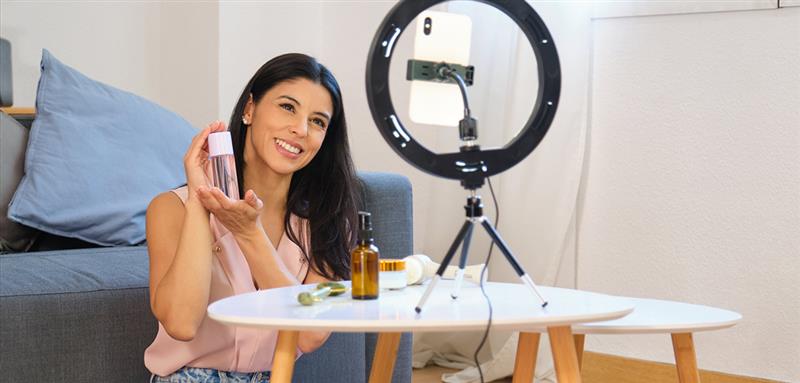“Dupe fever” has taken over social media, but it has also raised legal alarms. Influencers who promote low-cost products that try to resemble those of major luxury brands without mentioning the name of those brands or advertising agreements, are posing new legal challenges. Where can we draw the line between legitimate inspiration and unfair competition? And who can be held accountable if consumers feel misled?
TikTok® is full of them. So is Instagram®. The rush to find the next viral dupe has given rise to a new type of content creator: dupe hunters. Influencers who are dedicated exclusively to discovering, trying out and comparing low-cost products that seek to resemble in aroma, texture, finish or durability, those of the big luxury brands.
In simple terms, a dupe (abbreviation of duplicate) is just a replica with nuances, of the “cheap” version of a particular fragrance, or the characteristics of a cosmetic – or in fact, of any other product. Technically they are not fakes. Neither do they try to confuse consumers. And despite their name, they do not reproduce trademarks, designs or even packaging.
The interesting thing about this trend is that these products achieve commercial success without their manufacturers having to spend a cent on advertising. It is the influencer who, at their own risk, takes on the trickiest part of the work: telling the world that a certain supermarket lipstick costing barely 3 euros is – supposedly – the exact same shade as Charlotte Tilbury’s Pillow Talk, based on their personal experience, or that a low-cost fragrance is a perfect clone of Zadig&Voltaire’s This is Her!
The influencer gains followers happy to find a fantastic deal and viral products at reduced prices, the product goes viral and the manufacturer of the dupe sees its sales soar without moving a muscle. But what about the manufacturer of the imitated product who has spent thousands of euros developing and promoting it? Where are the legal limits when a dupe excels not because of what it is visually copying, but because of what the actual consumers-influencers promise on social media? And what if this promise falls short?
From look-alikes and perfume equivalents to dupes: a new turn of the screw
One of the premises of our legal systems as regards competition is that inspiration – not copying – is a valid tool in the corporate game: the imitation of business initiatives and services is freely allowed provided that certain limits are respected. That is, trademarks, designs and the exclusive rights of third parties may not be reproduced and unfair advantage must not be taken of a third party’s reputation (articles 11 and 12 of the Unfair Competition Law).
Over the years, the courts have defined the boundaries, ruling on the circumstances that must exist to find that trademark infringement and/or unfair competition have taken place when a manufacturer takes inspiration too far. Just a few weeks ago we looked at the Chocoflakes® case, in which a Spanish company in the food industry was found to have committed trademark infringement due to imitating the appearance and packaging of certain breakfast biscuits of another well-known brand in the industry.
In the area of cosmetics, the famous Moussel® case gave rise to a fierce legal battle between two manufacturers of personal hygiene products, due to the reproduction of elements on certain containers which were competitively unique: a distinctive color, a peculiar design and the layout of the items on the label were key factors in tipping the balance in favor of the owner of the original product.
A different example, albeit one that also ended in a finding of liability, was that of perfume equivalents. In this case, the manufacturers of the own brand products did not copy the shape or appearance of the perfume of reference nor use registered trademarks on the bottles. However, they did use equivalence lists that expressly referred to registered trademarks so that consumers would know which high-end perfume their fragrances were similar to. The strategy was based on the purported lawfulness of the necessary, descriptive or referential use of the trademarks. However, the courts rejected this argument, underscoring that practices such as these exceeded legal limits and constituted a clear exploitation of a third party’s reputation (the judgments can be found here and here).
In all these cases it was clear who was responsible: the manufacturer of the imitations. However, the manufacturers of dupes do not replicate or imitate trademarks or packaging, nor do they mention – at least not directly – the brands they conjure up and do not duplicate the packaging or the logos. It is the influencers who make these products go viral by presenting them as personal recommendations, without paid advertising. And this gives the message even more power.
But what happens if this opinion is directed (or even financed) by the manufacturer of the dupe?
Although the product itself does not infringe exclusive rights – such as trademarks, designs or patents – the way in which it is advertised through comparisons by influencers, especially when it is a covert collaboration, can have legal consequences.
The obligation of the content creators to clearly identify all sponsored content or paid partnerships is not a mere formality. Failing to do so can constitute unlawful advertising under legislation in force and, in some cases, it can go further: if the manufacturer of the dupe is behind the strategy, regardless of whether it is facilitating the product, molding the content or suggesting which high-end reference the product is imitating, such conduct could be considered trademark infringement, taking unfair advantage of a third party’s reputation or even unfair competition based on deceit.
In these scenarios it is not only the prestige of the dupe’s manufacturer that is at stake, but also a specially protected legal asset: consumer trust. A study by Trustpilot in December 2023 was highly revealing: 49% of social media users felt they had been scammed after purchasing a viral dupe.
If the average consumer believes, after seeing a post by an influencer, that the dupe is comparable to the original – same duration, same effect, same characteristics – and the promise does not live up to reality, this could constitute an unfair commercial practice as it is misleading. This is set out in the General Consumer and User Protection Law (Legislative Royal Decree 1/2007) and the Unfair Competition Law, which require all comparisons between products to be objective, verifiable and not misleading.
In short, social media has become a powerful marketing tool and content creators can undoubtedly boost trends and products, but it is essential that manufacturers and influencers understand that their role is not exempt from responsibility: if consumers feel misled, if the original trademark is adversely affected or if the comparison does not stand up to legal scrutiny, the problem can flare up far beyond the algorithm.






